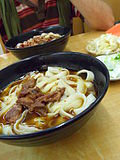Chinese noodles
Chinese Noodles
Chinese noodles are a staple food in Chinese cuisine. They come in a variety of shapes and sizes and can be served in soups, stir-fried, or as a cold dish. Noodles are an integral part of Chinese culture and have a history that dates back over 4,000 years.
History
The history of Chinese noodles can be traced back to the Han dynasty, where they were first mentioned in historical texts. Over the centuries, noodles have evolved and diversified, becoming a key component of Chinese culinary tradition.
Types of Chinese Noodles
Chinese noodles can be broadly categorized based on their ingredients, shape, and preparation method.
Wheat Noodles
Wheat noodles are the most common type of noodles in northern China. They are made from wheat flour and water, and sometimes eggs are added for texture and color. Common varieties include:
- Lo mein - Soft, boiled noodles often served with vegetables and meat.
- Chow mein - Stir-fried noodles that are crispy or soft, depending on the preparation.
Rice Noodles
Rice noodles are popular in southern China and are made from rice flour and water. They are often used in soups and stir-fries. Varieties include:
- Ho fun - Wide, flat noodles often used in stir-fried dishes.
- Rice vermicelli - Thin noodles used in soups and salads.
Other Varieties
- Cellophane noodles - Made from mung bean starch, these noodles are transparent and often used in soups.
- Liangpi - Cold skin noodles made from wheat or rice flour, popular in Sichuan cuisine.
Preparation Methods
Chinese noodles can be prepared in various ways, including boiling, steaming, stir-frying, and deep-frying.
Boiling
Boiling is the most common method for cooking noodles. Once boiled, they can be served in soups or stir-fried.
Stir-frying
Stir-frying is a popular method that involves cooking noodles quickly over high heat with vegetables, meat, and sauces.
Steaming
Steamed noodles are often used in dim sum dishes and are known for their soft texture.
Regional Variations
Chinese noodles vary significantly across different regions of China, reflecting local tastes and ingredients.
Northern China
In northern China, wheat-based noodles are prevalent. Dishes such as Daoxiaomian from Datong are popular.
Southern China
In southern China, rice noodles are more common. Dishes like Liangpi are enjoyed for their refreshing taste.
Cultural Significance
Noodles hold cultural significance in China, symbolizing longevity and prosperity. They are often served during celebrations such as birthdays and the Chinese New Year.
Related Pages
Media
Transform your life with W8MD's budget GLP-1 injections from $125.
W8MD offers a medical weight loss program to lose weight in Philadelphia. Our physician-supervised medical weight loss provides:
- Most insurances accepted or discounted self-pay rates. We will obtain insurance prior authorizations if needed.
- Generic GLP1 weight loss injections from $125 for the starting dose.
- Also offer prescription weight loss medications including Phentermine, Qsymia, Diethylpropion, Contrave etc.
NYC weight loss doctor appointments
Start your NYC weight loss journey today at our NYC medical weight loss and Philadelphia medical weight loss clinics.
- Call 718-946-5500 to lose weight in NYC or for medical weight loss in Philadelphia 215-676-2334.
- Tags:NYC medical weight loss, Philadelphia lose weight Zepbound NYC, Budget GLP1 weight loss injections, Wegovy Philadelphia, Wegovy NYC, Philadelphia medical weight loss, Brookly weight loss and Wegovy NYC
|
WikiMD's Wellness Encyclopedia |
| Let Food Be Thy Medicine Medicine Thy Food - Hippocrates |
Medical Disclaimer: WikiMD is not a substitute for professional medical advice. The information on WikiMD is provided as an information resource only, may be incorrect, outdated or misleading, and is not to be used or relied on for any diagnostic or treatment purposes. Please consult your health care provider before making any healthcare decisions or for guidance about a specific medical condition. WikiMD expressly disclaims responsibility, and shall have no liability, for any damages, loss, injury, or liability whatsoever suffered as a result of your reliance on the information contained in this site. By visiting this site you agree to the foregoing terms and conditions, which may from time to time be changed or supplemented by WikiMD. If you do not agree to the foregoing terms and conditions, you should not enter or use this site. See full disclaimer.
Credits:Most images are courtesy of Wikimedia commons, and templates, categories Wikipedia, licensed under CC BY SA or similar.
Contributors: Prab R. Tumpati, MD







